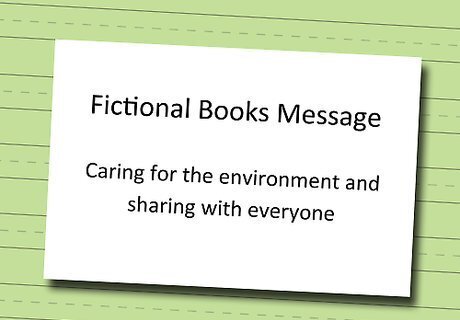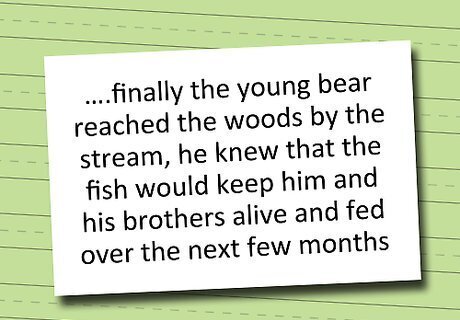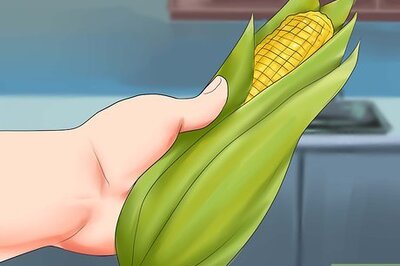
views
Researching and Brainstorming

Read a variety of children’s books. As you begin thinking of ideas for your children’s book, it’s very helpful to read others’ work. Go to your library or children’s bookstore and spend a few hours browsing. Think about which books appeal to you most, and why. Do you want your book to have illustrations, or will it be text-only? Do you want to write fiction or non-fiction? Non-fiction or informational books require research or knowledge of the subject matter and can be good if you're an expert about something like dinosaurs, meteors or machinery. For good fiction inspiration, read the classics. Don't limit yourself to recent works––go back in time and read stories that have withstood the test of time and try to find for yourself what it is about them that is so everlasting. For example, check out such books as: Goodnight Moon, Where the Wild Things Are, The Polar Express, and other favorites. Check out fairy tales. The entertainment industry is currently experiencing a greatly revived interest in fairy tales and turning them modern. Since the majority of fairy tales are in the public domain, you're free to snaffle up characters and plots and take them to completely new places with totally new attitudes!

Consider which age group interests you as a writer. The term “children’s books” covers everything from board books with one word on a page to chapter books, novels and non-fiction factual books written for kids in middle school and teens (young adults). The plot, content, and themes of your book need to be age appropriate for your intended readers for them to be appealing (remember that parents are the ultimate gatekeepers who can determine whether or not a child reads your book). Picture books are suitable for younger children. They tend to be in full color, which makes them more expensive to print, so bear that in mind. On the plus side, they tend to be shorter, but then your writing needs to be very good to grab interest and keep the story tight. Chapter books and non-fiction/informational books are for older children. Starting with easy-readers through to teen novels, there is a great deal of scope here but there is also likely to be a lot more writing and researching involved. Don't neglect the potential for a book of poems or short stories. If you write either, you'll find children love both too.

Decide whether your book is mostly words, mostly pictures, or a bit of each. If your book is for younger readers, you’ll want to include a lot of artwork that complements your writing. If you’re an artist, you may draw your own illustrations - many children’s book authors do. If you’re not, you may want to hire a professional illustrator to create the artwork for your book. For older children, diagrams, drawings, and occasional bright images may be sufficient; in some cases, no images at all might work too. Before seeking an illustrator, sketch your ideas for the pictures that will go along with each page. This will help you with the next stage of editing, and you’ll be able to give the sketches to the potential illustrator to give him or her an idea of what you want. Illustrators have very different styles, so it’s important to conduct thorough research before making a choice. Do an online search for illustrators and look at professional portfolios. If hiring a professional isn’t in your budget, you might want to ask a friend or family member who is artistic to create artwork for your story. Consider photography as another option for adding images to your book. If you enjoy taking photos, you can use real-life scenery, stills using stuffed toys and so forth. You can also use a digital photo program to add elements that you can't photography easily.
Preparing the Book Contents

Decide on the main components of your story. Write down your ideas in a notebook. Some basics to bear in mind include: Whether they’re geared toward children or adults, most great stories share a few basic elements: The main character, supporting characters, an interesting setting and a plot that includes a central conflict, trouble brewing, a climax, and a resolution. For non-fiction or informational works: The book needs to inform the reader about history, people, events, real things or how-to instructions. Picture books: These require a lot of illustration, usually in full color, which can make printing more expensive. Text is limited but needs to be both good and original––there is quite an art to limiting words and still putting across and excellent story.

Consider incorporating a message for fiction works. Many children’s books include a positive message, ranging from simple standards, like “share with others,” to more complex life lessons on topics like handling the death of a loved one or how to think about big issues like caring for the environment or respecting other cultures. It isn’t necessary to include a straightforward message, so don’t force it––if you do, your lesson may come off as heavy-handed, which won’t be appealing to kids.

Be creative. If writing fiction, this is your chance to write something silly, strange, nerdy, dreamy, fantastical. What inspired you as a child? Go there, explore those ideas. This doesn’t mean you should throw in something wacky for no good reason, though. Tap into feelings that are sincere and actions that make sense for your character. Readers can immediately pick up on writing that seems false, and that’s when they put down the book. And if writing non-fiction, this is your chance to share your knowledge and research with future generations of chefs, engineers, and artists! Importantly, be creative but also accurate––it's a fine balance between keeping it light and still ensuring that the content is fact-checked thoroughly and understandable or doable by children. Consider pitching the idea to a child, like a niece or nephew, cousin, or the child of a close friend. Children typically give very honest feedback, so they can help you evaluate if your story will be interesting to their age group.
Drafting Your Story

Write your first draft. Don’t worry about how it sounds - you won’t be showing it to others just yet. Concentrate on getting your story or book outline on paper, and worry about honing it later. Many a book has failed to eventuate thanks to wrong-end perfectionism––let the red pen come out after the words are down on paper.

Be aware of the age of your readers as you write. Your vocabulary, sentence structure, and sentence length should be appropriate for the age group for whom you’re writing. If you're unsure, talk with various children of the age group you're writing for, and share some of the words you're keen to use, to gain an idea of the extent of their comprehension. While it is good to push children's learning a little, there is a limit to having every second word require a dictionary! Write concise sentences that clearly communicate the ideas you want to share. This is a basic tenet of good writing for all ages. And it's especially important for children who are learning to grasp meaning from ever-increasing complexity. Don’t underestimate the intellect of your readers. Children are fiercely intelligent, and if you make the mistake of writing “down” to them, they’ll quickly get bored with your book. Even though the themes are age appropriate and the sentences are simply written, your writing concepts should captivate your readers. Keep up-to-date. Just because something doesn't interest you or seems too technical doesn't mean you can avoid it. Children want to read what's current in terms of language and concepts, so if that means learning about innards of such things as programming or texting lingo so that your story or information comes across as genuine, embrace the learning opportunity with enthusiasm!

Provide a resolution or realistic outcome at the end of a fiction book. The ending doesn't always have to be happy––that can be a real disservice to a young reader, as life isn't about constant happy endings. The ending should be as strong as the rest of your book and not feel abrupt or disjointed. Sometimes it helps to take a break and come back to the book later when a suitable conclusion will have shaped itself in your subconscious in the meantime; while for others, the conclusion is known well before the book begins! For non-fiction, always seek to provide a conclusion to end the work neatly. It might be an observation of where the topic is likely to head in the future, or a summary of what main points can be taken from the book, or perhaps a whimsical reflection about what the reader might like to do/read/learn next.
Revising to Improve

Revise your manuscript. This step should be repeated over and over until your manuscript is polished. You may discover that entire portions of your story aren’t working, or that you need to write in a new character. If you’re working with an illustrator, you’ll find that the addition of artwork can change the tone of your story. Go through several passes until you have a manuscript you’re ready to show people. Learn to let go. While it can be hard to discard work you've spent hours and hours perfecting, only to find it doesn't fit or really work, it's part of being a writer. Knowing what to leave out is an essential part of the art of writing. To gain objectivity, take time away from your work and come back refreshed. Judy Blume Judy Blume, Writer The revision process is an essential time to elevate your writing. "I'm a rewriter. That's the part I like best...once I have a pile of paper to work with, it's like having the pieces of a puzzle. I just have to put the pieces together to make a picture."
Check spelling and grammar. Once you have your story set, read through your manuscript to check specifically for spelling and grammar errors. In addition to misspelled words and common grammar errors, check for overused words, commonly confused words (like there/their/they're), and awkward or long sentences. Spell check is a useful tool, but it won't catch everything. Re-read your manuscript a few times to make sure you've caught all the basic errors. Give yourself a few days in between each read so that you can come at your manuscript with fresh eyes each time. Remember, long or complicated sentence may confuse young readers. One of the challenges in writing for children is communicating complicated stories clearly and concisely.

Show your manuscript to others. Start by giving your manuscript to family and friends. It isn’t always easy to get a straightforward reaction from loved ones who might want to save your feelings, so consider joining a writing workshop or forming a writer’s group so you’ll be able to get honest feedback on your manuscript. Remember to show your book to your primary audience: children. Read your manuscript to kids and pay attention to whether they seem to “get it,” which parts make them bored, and so on. Consider whether your book appeals to parents, teachers and librarians. They are the ones who will be purchasing your book, so it should be interesting to them, too. Once you’ve got feedback from a variety of sources, edit your manuscript again.
Publishing Your Book

Self-publish. This is a viable and respectable option in today’s publishing world. Search online for companies that will help you self-publish your book. You may want to create an eBook, or you may want to have copies of your book printed. You can spend as little or as much money as you want on self-publishing, and you’ll be able to avoid the lengthy process of publishing a book through more traditional means. Some self-publishing companies provide higher quality services than others. Before choosing a company, look into the type of paper they use, and try to obtain samples of other books they have published. When you self-publish a book, you still have a shot at getting it published by a traditional publishing house down the road. In fact, you’ll have a sample of your finished book to send them with your pitch. If it looks beautiful, this can give you an edge over other submissions.

Find a literary agent. If you have your heart set on publishing your book with a traditional publishing house, it’s best to find an agent to help you through the process. Research agents who work with children’s books in the United States can be found at www.writersmarket.com. Similar agent organizations will exist in other countries too. Send agents a query letter and a book synopsis. If agents are interested, they’ll reply with a request to see the manuscript. It may take weeks or months to receive a reply. If your book is not picked up by an agent, you may send your query letter and synopsis directly to publishers that accept unsolicited manuscripts. Research companies that publish books like yours before contacting publishers. If your book is picked up by an agent, he or she may ask you to make revisions to the manuscript to make it more appealing to potential publishers. When it’s ready, the agent will send pitches to publishers that seem like the right fit. Again, the process can take months, and there’s no guarantee your book will be published.

Publish for local consumption only. Writing a children's book is by itself a huge accomplishment. There's no need to seek wide publication if you don't want to. Sometimes it's more personal to just share it with the people who matter. Consider printing the manuscript at the copy store and binding it to give to a few friends, or to children in your family. Many copy stores have services that allow you to print and bind full-color booklets that look very professional.




















Comments
0 comment